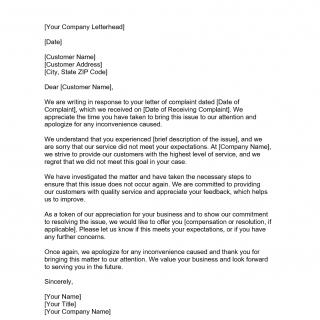Response to letter of complaint
A response to a letter of complaint is a formal document used to address a complaint that has been received by a company or individual. The main purpose of this form is to provide a written response to the sender of the complaint, acknowledging their concerns and providing a resolution or explanation for the issue raised.
The response to a letter of complaint typically consists of several parts, including an introduction, a statement of the issue, an explanation of the resolution or action taken, and a closing statement. The introduction should thank the sender for their correspondence and acknowledge the receipt of the complaint. The statement of the issue should provide a clear and concise summary of the complaint, and the action taken should explain what steps have been taken or will be taken to address the issue raised. The closing statement should express appreciation for the sender's business and provide contact information for further communication if necessary.
Important fields that should be included in a response to a letter of complaint include the date of the incident, the sender's contact information, the recipient's contact information, and a clear description of the issue raised. It is also important to consider the tone and language used in the response, as it should be professional, respectful, and empathetic.
When compiling a response to a letter of complaint, the data required will depend on the specific issue raised, but it is important to gather all relevant information before responding. Additional documents that may need to be attached include any relevant receipts, invoices, or contracts.
Application examples and use cases for a response to a letter of complaint include addressing a customer's concerns about a product or service, responding to a complaint from an employee, or addressing a complaint from a regulatory agency. The benefits of using a response to a letter of complaint include the ability to maintain good customer relations, document the issue and response, and prevent future complaints. The challenges and risks include the possibility of legal action, negative publicity, or damage to the company's reputation.
Related and alternative forms include a response to a request for information, a response to a request for proposal, or a response to a legal complaint. The differences between these forms lie in the specific purpose and content of the document.
The response to a letter of complaint can have a significant impact on the future of the parties involved. A well-written response can help to retain customers and prevent further complaints, while a poorly written or inadequate response can lead to legal action or negative publicity.
The response to a letter of complaint is typically submitted via mail, email, or fax, and should be stored in a secure location for future reference.

